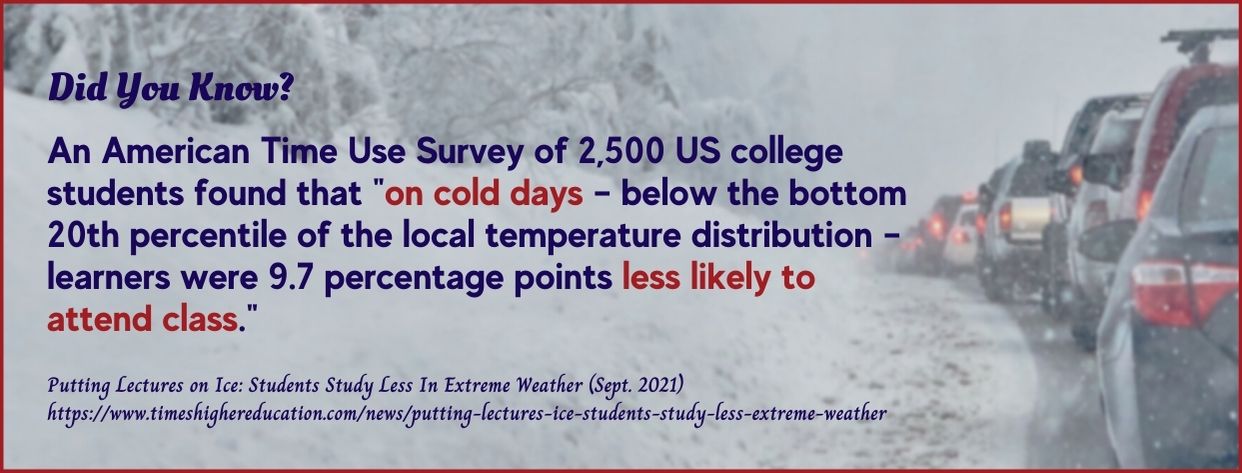Find Your Perfect School
An American Time Use Survey collated with meteorological data found that weather greatly influences student attendance and academic habits. During cold days, students were 9.7% less likely to attend their classes resulting in 27 minutes less time, on average, spent in lectures.
Hot days also reduced their class attendance by 8.8%, meaning 20 minutes less time spent in the classroom. Time devoted to independent studying also decreased by an hour, not to mention the larger effect of more extreme temperatures.
Many other studies show that, indeed, the weather directly impacts mood and motivation levels among individuals. Sunshiny days are typically associated with optimism, while dreary weather can cause anxiety. Seasonal Affective Disorder (SAD) is a type of depressive disorder associated with the changing seasons and lasting from fall to winter.
With this in mind, we chose 30 colleges and universities that have nearly year-round terrific weather, excellent academic standing, and great entertainment options. Many of these are in the western United States – California, Arizona, and Hawaii – while others are from states with mild seasons like Texas, Arizona, and Florida.
California Institute of Technology
Pasadena, California
CalTech students enjoy the Mediterranean climate that allows them to engage in indoor and outdoor activities the whole year round! The winters are cooler, and summers are hotter than the surrounding coastal area. Pasadena receives more rainfall per year, too.
The temperature ranges between 16°C and 24°C during the first few months, with the colder days also bringing in more rain. By April, the days become warmer. The rains are less frequent and heavy. May and June bring dry, cloudy days, while July through October means hotter days with sparse rains.
Just 11 miles from downtown Los Angeles, Caltech offers a wide range of activities for students to enjoy. The Pasadena Playhouse and Old Town Pasadena are favorite hangouts near the campus. The annual Roses Parade and Rose Bowl football games are highly anticipated, while cultural institutions like the Pasadena Symphony and the Beckman Auditorium offer year-round entertainment.
CalTech’s highly selective admissions process ensures that its students make significant contributions to its STEM-centric programs. Students engage in pure and applied sciences research, enroll in one or more of its six academic divisions, and abide by its honor code. Caltech is a perennial presence in the world’s best school listings, particularly in physical sciences, engineering, and technology.
Georgia Institute of Technology
Atlanta, Georgia
GeorgiaTech is known for its green spaces and suburban atmosphere, making it among Georgia’s best campuses! Students praise the humid subtropical climate characterized by four distinct seasons with mild transitions. While Atlanta receives generous precipitation, the rains are evenly distributed throughout the year. But spring and early fall may be drier than usual. The summer months can be hot and humid but relieved by cool winds, while the winter months are cool with a low risk for snowstorms.
The sprawling campus has four major parts – East Campus, West Campus, Technology Square, and Central Campus – with each part having specific characteristics. Students take their classes and perform research at the Central Campus, and the East Campus has their living complexes. Atlanta’s melting pot environment means students enjoy its multicultural offerings and cosmopolitan vibe while also savoring the numerous events at GeorgiaTech.
GeorgiaTech is renowned for its academic excellence in engineering, computer science, and business analytics. Many of its engineering programs, such as industrial, aerospace, chemical, and biomedical, are among the best in the world. Considered among the most innovative, its students are expected to contribute to its growing list of innovations and entrepreneurial start-ups. Students thrive in its cooperative education and internship programs, too.
Stanford University
Stanford, California
Stanford students thrive in the warm-summer Mediterranean climate, whether in their studies or extracurricular activities. The summer days are warm and dry. It doesn’t get hot and humid either! There are more than 260 sunny days every year, with about 60 days of rain and zero snow days. With only 17 inches of rain per year, Stanford feels like it’s summer the entire year! Even during the winter season, the days and nights are cool but not cold.
On-campus attractions are aplenty, too, so students don’t have to venture outside. The 24 galleries, terraces, and courtyards in the Cantor Center for Visual Arts can take more than a day to explore. Outdoor installations, murals, and sculptures are scattered throughout the campus, too, so walking is a pleasure.
Cultural activities abound, including music festivals and Shakespeare shows. Further afield lies the attractions of Palo Alto, from the awesome outdoors of the Baylands Nature Preserve to the farmers market, shops and restaurants, and museums of its downtown area.
Considered among the world’s top universities, Stanford offers a wide range of academic programs in its seven schools. All of them are on the same campus, so students enjoy a tight-knit sense of community. Medicine, law, business, and education are its most popular areas of study, with its researchers in medicine known for their numerous innovations in cancer therapy and human heart transplant.
Duke University
Durham, North Carolina
Duke’s location in a humid subtropical climate contributes to its popularity among students who prefer mild weather. Durham may have hot and humid summers, but the rains and occasional thunderstorms bring cooler days and nights; the summer temperature ranges between 26°C and 37°C. The winter season brings about 6.8 inches of snow, but it melts in a few days. Overall, students enjoy a warm and temperate climate conducive to studying and enjoying life.
Within its 8,600-acre campus, Duke has numerous buildings of interest, including the Gothic-style Duke Chapel and the Medical Center. Students live in the East Campus with its Georgian-style buildings. Duke’s vibrant on-campus culture is complemented by Durham’s numerous jazz festivals, art exhibitions, and concerts.
Be here for the OUTsouth Queer Film Festival, Bull Durham Blues Festival, and American Dance Festival! Not too far away are outdoorsy activities at the Eno River State Park, where hiking, biking, fishing, and rock climbing are popular.
Duke’s overall undergraduate admission rate – under 6% of applicants – combined with its rigorous program makes it among the best in the world, academics-wise. Many of its students are Rhodes, Truman, Marshall, Udall, and Goldwater scholars, too, while the roster of faculty members boasts of several Nobel laureates and Turing awardees.
University of California Berkeley
Berkeley, California
Classified as a warm-summer Mediterranean climate, Berkeley enjoys temperate and warm weather during most of the year. The summers are warm and dry with less rain than in the winter months, typically cool and wet. But the summers are cooler due to the upwelling ocean currents, a natural occurrence that contributes to foggy mornings and cool nights. Rainstorms during the winter months are punctuated by bright sunny days, and there’s little to no snow. Spring and fall are beautiful if only fairly short and transitional, seasons.
UC Berkeley’s campus features several wooded areas, such as the Eucalyptus Grove and Grinnell Natural Area, within its 1,232-acre expanse. There are several research facilities, including the Lawrence Berkeley National Laboratory, an ecological preserve, a recreation center, and several museums and gardens. Downtown Berkeley is a few minutes to the west, where students shop at Solano Avenue, bike at hike at the San Francisco Bay Trail, and enjoy their fill at Gourmet Ghetto restaurants.
Students are enrolled in more than 350 degree programs at the undergraduate and graduate levels. UC Berkeley’s 14 colleges and schools emphasize research, invention, and innovation, a tradition that has produced scientific breakthroughs from the Manhattan Project to entrepreneurial ventures.
University of North Carolina Chapel Hill
Chapel Hill, North Carolina
UNC-Chapel Hill students say that the best times of the year are from early May to mid-June when the weather is warm and then from mid-August to early October when it’s cool. The summers can be quite hot with 216 sunny days per year, while the winters are cold but short, usually with four inches of snow per year. Many days are partly cloudy with intermittent rain showers, with Chapel Hill receiving an average of 46 inches of rain a year.
The North Campus features the Wilson libraries, the Pit and the Davis House, and the residence halls and classrooms. The Middle Campus is where students find recreation, sports, and fitness facilities, while the South Campus is home to the UNC Hospitals and schools of medicine and business. Chapel Hill is a large metropolitan area with mural-painted buildings, a popular street fair (Festifall), and plenty of entertainment options, from the quaint downtown to the Eno River greenways.
UNC is a top-ranked public university – 5th in the country and 28th among national universities (2021 US News rankings) – that attracts students from all walks of life. Low-income students can avail themselves of its Carolina Covenant and graduate without student debt. Medicine, business management, and pharmacy are among their strongest suits.
Florida Institute of Technology
Melbourne, Florida
The humid subtropical climate characterizes Melbourne means that Florida Tech students enjoy a wide range of physical activities conducive to their overall health. There are 234 sunny days and 120 days of precipitation, usually rain averaging 54 inches per year, meaning students can hit the beach on most days. The seasons are markedly different, with a hot and wet season from late May until October followed by a warm, dry season from November until April. Thanks to the cold fronts blowing in from the north, the winter months are cooler.
On-campus activities reflect the tropical climate, too, with students enjoying beach volleyball, swimming at the outdoor pools, and tennis. Outdoor festivals in Melbourne are common, too, with the Main Street Fall Festival, Oktoberfest, and Summer Friday Fest Family Street Party being the most anticipated. Free access is guaranteed to Melbourne’s miles of public beaches, where the norms are sailing, snorkeling, and sunbathing.
Florida Tech offers undergraduate and graduate degree programs in its four colleges: Business, Psychology and Liberal Arts, Aeronautics, and Engineering and Science. About half are enrolled in Engineering and Science programs, a testament to its recognized strengths in these areas of study. Student support services include health services and health insurance, tutoring and mentoring, and campus safety.
University of Southern California
Los Angeles, California
With its Mediterranean climate, the City of Angels attracts students who want the best work-life balance and ethnic diversity, cosmopolitan vibe, and proximity to fame and fortune. Los Angeles has two climate classifications within its jurisdiction – warm-summer Mediterranean climate on the coast and downtown areas; and hot-summer Mediterranean climate to the west. Overall, the city has a subtropical climate with hot, sunny summers and very mild, if fairly rainy, winter months. There’s plenty of sunshine the entire year, with only about 35 days of rain every year.
Students don’t have to go far for entertainment! The USC Village is a sprawling 104,000-square-foot, one-stop shop for students looking for places to shop, exercise, and dine – or unwind from their studies. There are plenty of accessible off-campus attractions, including Exposition Park and its Rose Garden, the California Science Center, and the Natural History Museum. The bus and subway will also take you farther afield in Los Angeles, including Sunset Boulevard, the Sunset Strip, The Grove, and Rodeo Drive.
USC’s highly selective admission policy ensures that its reputation among the country’s top universities is intact. Students thrive in an academic environment described as a balance between the arts and sciences, and on-campus residence is highly encouraged.
Florida International University
Miami, Florida
Miami has a tropical climate that lends itself to “nice weather,” a common refrain among FIT students, locals, and tourists alike. While the city gets an average of 59 inches of rain per year, it’s sunshiny for 248 days a year, too. The rainy days total about 129 days in a year, although there are hurricanes, too. The coldest month, usually January has temperatures averaging 59.5°F, while the summer months have balmy 90°F days.
There are miles of public beaches that FIU students can access for free, and swimming, sunbathing, diving, boating, sailing, and fishing are popular activities. On-campus activities are enjoyed amidst the FIU’s numerous lakes and nature preserves, even an arboretum, which features lush vegetation that provides breezy shade. Students head to the Sky Lounge to unwind, the Kenan-Flagler Family Discovery Gallery for its interesting displays, and the Wolfsonian-FIU museum for its pre-war collections.
Among the largest in Florida and the US, FIU is known for its research-centric approach to higher education in its colleges and centers, labs, and facilities. Students are enrolled in over 190 programs of study, including business, law, and medicine. The FIU Honors College is nationally recognized for its academic excellence and exceptional research support, internships, and honors housing.
Louisiana State University
Baton Rouge, Louisiana
Baton Rouge’s humid subtropical climate means snowfall is rare, as are extreme temperatures, including extreme swings. Cold winter fronts bring in cool temperatures, although these are usually a welcome relief, not to mention lasting for brief periods. The yearly average temperature is 68.4°F with January being the coldest (51.7°F) and July the hottest (68.4°F). The winters are typically mild, while the summers are hot and humid with moderate to heavy rainfall. Hurricanes are the greatest threat.
With its eight on-campus museums, LSU offers its students a wide range of entertainment and educational opportunities. LSU even has four other museums in Baton Rouge! The city itself is a major hub for cinema, research, industrial, medical, and petrochemical companies, so internships and employment opportunities abound. LSU also has a beautiful and walkable campus with groves of stately oaks, historic buildings, and green spaces.
LSU is among the few land, sea, and space-grant R1 institutions with extensive research facilities and research funded by federal agencies. Known for its academic excellence in its medical, veterinary, law, and business programs, it’s a nationally ranked institution with a selective admission policy.
University of Texas-El Paso
El Paso, Texas
El Paso’s climate transitions between a hot and a cold desert climate, meaning there’s plenty of sunshine for an average of 302 days per year. The hot summers have little humidity, but the winters range from cool to mild, while the 8.8-inch average annual rainfall lasts from June until September.
The Sun City also gets some snow, but these are uncommon, as are major snowstorms and sandstorms. Note that the amount of snow varies between areas in and around El Paso, and, thus, physical activities should be planned accordingly. Temperatures range between 95°F in the summer and 31.3°F in the winter.
UTEP’s huge campus offers a wide variety of venues for rest and recreation, and it’s partly due to the nice year-round weather. The Student Recreation Center has an Outdoor Adventure program, too, aside from the numerous on-campus walking and biking trails. Students also have easy access to the Franklin Mountains State Park and the privilege of participating in El Paso’s numerous festivals, including the Fiesta de las Flores, Neon Desert Music Festival, and El Paso Balloonfest.
UTEP is renowned for being the university with the most Hispanic engineers with master’s and doctoral degrees in the US. There are over 170 degree programs offered, and it has the country’s only bilingual MFA program.
Pepperdine University
Malibu, California
With sunshiny days and spectacular ocean views, Pepperdine’s campus is among the most beautiful in the country! Malibu’s warm-summer Mediterranean climate means that students love the warm and dry summers with about 281 sunny days per year and 20-inch average annual rainfall. While snow is extremely rare, it did fall at higher elevations, with the most recent being on January 25, 2021. Pepperdine, indeed, is blessed with fantastic weather that, when considered with its beach resort vibe, makes it a great college.
Many points on the campus offer scenic views of Los Angeles and the Palos Verdes Peninsula, Catalina Island, and Santa Monica Bay. The Mediterranean Revival Style used on most on-campus buildings contributes to their quaint charm, too.
Malibu has miles of the best beaches in California, such as Las Flores Beach and Malibu Beach, where surfers, swimmers, and sunbathers enjoy the fantastic weather nearly every day. Malibu doesn’t run short on arts and culture with the Malibu Arts Festival, Malibu International Film Festival, and Polar Plunge.
Pepperdine has academically rigorous programs offered in its Graziadio School of Business and Management and Seaver College of Letters, Arts, and Sciences. Students are expected to excel in seven core subjects, including maths and science, economics, and composition.
University of San Diego
San Diego, California
San Diego’s most prominent universities are on this list simply because they combine fantastic year-round weather and excellent academics! Beach life becomes addictive, too, with the Pacific Ocean just a hop-and-skip away. The arid subtropical climate results in fair weather (spring-like) most days of the year and is characterized by warm, sunny summers with mild, rainy winters. But when the Santa Ana wind blows, the temperature significantly increases.
USD was founded on the philosophy that beautiful surroundings and educational experience were directly correlated, and USD is among the most beautiful campuses in California! Overlooking Mission Bay and San Diego, the campus features Plateresque architecture-style buildings set amidst lush greenery. San Diego is a popular hangout for students, too, with its rich variety of indoor entertainment and outdoor adventures, from museums and gardens to retail shops and restaurants.
Students enjoy a balance of work and play, which allows them to contribute to USD’s mission. USD is known for its commitment to advancing academic excellence, creating an inclusive and diverse community, and promoting knowledge. Students are recognized for their compassionate service as much as for their excellent academics.
Arizona State University
Phoenix, Arizona
The warm, desert climate of the Phoenix Metropolitan Area means that it’s among the sunniest in the country, with 211 sunny days per year and a steady 73ºF temperature, on average. There are only 36 rainy days with an annual precipitation rate of nine inches, meaning there are plenty of days for frolicking among the Sun Devils. Snow is uncommon, but it does fall by about an inch every decade or so.
ASU’s Downtown Phoenix campus has an urban vibe in keeping with its environment. The large academic buildings blend well with the retail and commercial official buildings, while many of its existing structures have been repurposed for contemporary needs.
Students have easy access to most of Downtown Phoenix’s delightful shops, high-end spa resorts, vibrant nightclubs, and even golf courses. The Desert Botanical Garden is a must-see, too, for its native plants, including cacti, and peaceful vibe.
ASU is the US’ largest public research university known for its strong inclusion policy. According to its charter, its advancement of research, inventions, and innovations of public value are among the measurements of its success. ASU is known for its active and meaningful community involvement, too.
Texas A&M University Galveston
Galveston, Texas
With its humid subtropical climate, Galveston provides an excellent place for TAMUG students to thrive. The mild climate is characterized by 203 sunny days per year, on average, with a 40-inch annual average rainfall. The Gulf of Mexico has a big impact on its climate, too, with prevailing winds bringing in moisture. The summer temperatures range between 90°F and 80°F while the winter months bring in temperate temperatures, usually between 60°F and 50°F. Galveston is at its best from late March to mid-May, followed by mid-October to mid-November.
TAMUG students have plenty of activities for their entertainment on campus. There are tennis courts, volleyball courts, a student center, and a swimming pool, among other amenities. The arts and culture venues and activities abound in Galveston, from the annual Mardi Gras festival to the jazz and blues festival. Head to the Galveston Island Historic Pleasure Pier for amusement rides and good food, and then to the Galveston Island State Park for kayaking, fishing, and hiking.
TAMUG’s programs are known for their strong focus on the maritime sciences, including marine engineering technology, marine fisheries, and marine biology. The Texas A&M Maritime Academy is recognized for its academic excellence too, as well as for its sailing and rowing teams.
University of California San Diego
San Diego, California
San Diego’s weather is like vanilla – it’s such a pleasant place to be in that nearly everybody finds its fairly consistent sunny days favorable! Here, the sun shines about 266 days in a year, the temperature stays in the 70s range year-round, and the 12-inch average annual rainfall brings welcome relief from the sunshine. The semi-arid Mediterranean climate means warm, dry summers followed by mild winters with little snow and ice.
Due to its coastal location, San Diego is a place for sun-seekers and adrenaline junkies looking for adventure on land, sea, and air due to its coastal location. Coronado Beach is a surfing destination, while the Torrey Pines State Natural Reserve has sandstone cliffs suitable for adventurous activities. Head to La Jolla Cove for Instagram-worthy scenes, explore Balboa Park’s theaters, gardens, and museums, and sign up for a guided tour.
UC San Diego is a 60-year-old institution, but its youth doesn’t mean it lacks achievements! It’s a Public Ivy known for its academic excellence and research contributions. Among its faculty members are Nobel laureates and winners of the Fields Medal, the Pulitzer Prize, and MacArthur Fellowships.
University of Miami
Coral Gables, Florida
If you want to visit Coral Gables, your best bet is from early November to late April because these months are excellent for warm-weather activities. But it’s still a great town to be in for UMiami the entire year, thanks to its tropical climate. The long summers can be wet but still sunshiny, albeit with cloudy days, while the short winters are mostly clear with comfortable temperatures. The temperature variations throughout the year are from 62°F to 90°F.
Coral Gables has an affluent character filled with popular landmarks and tourist attractions as a Mediterranean-themed planned community. Check out the Venetian Pool with its luxurious towers, grottos, and bridge; the Fairchild Tropical Botanic Garden with its butterfly display, tropical rainforest, and lakes; and the Lowe Art Museum with its fascinating artworks. UMiami, of course, has plenty of attractions on campus, including its botanical garden and arboretum, a campus theater, and the Student Center Complex.
Miami offers a wide variety of programs, from medicine and law to oceanography and atmospheric sciences, with a research-centric approach. As an R1 research university, its students are also engaged in faculty-led and independent research.
University of Arizona
Tucson, Arizona
Tucson is a chill city in the sense that it’s a great place to sit back, relax, and enjoy life, thanks partly to its warm summers and mild winters. The hot desert climate means only 12 inches of rain every year, usually during the summer monsoon and winter storms. Even the fall and spring seasons are dry, sunny, and warm! There are 286 sunny days with only 52 rainy days, and Tucson tends to be cooler than Phoenix. Catch Tucson at its best weather from early June to mid-July and then from mid-August to early October.
UArizona’s 390-acre campus has attractions of its own, but students are free to venture into Downtown Tucson and expand their entertainment options. The red brick-centric architecture is a distinctive feature of UArizona’s campus, and it’s seen in the Arizona State Museum buildings and the Centennial Hall.
The Mall’s grassy expanse is a great place to see and be seen, too. Tucson has plenty of cultural events, including the Festival of Books, Folk Festival, and Rodeo, and a rich assortment of shops, bars, and restaurants.
With 19 schools and colleges, UArizona is a comprehensive research university that emphasizes the value of research in academic and community advancement.
University of California Santa Barbara
Santa Barbara-Isla Vista, California
Santa Barbara has such great weather that it’s a popular tourist destination. However, unlike tourists, students at UC Santa Barbara enjoy living here full-time! With the Santa Ynez Mountains and the Pacific Ocean protecting the city from extreme weather, its Mediterranean climate is part of its reputation as the American Riviera. The cooler summers and warmer winters are due to the moderate temperatures brought by the westerly winds from the Pacific Ocean.
UCSB’s campus has four major parts, with the Main Campus featuring all the academic buildings and most of the residential accommodations. There’s also a university beach with miles of coastline, a lagoon, and numerous biking and walking paths.
The West Campus features the Coal Oil Point nature preserve with its extensive biking paths. The university itself is known for its cycling-friendly environment. Off-campus entertainment includes the 2,000-seat Arlington Theatre, the Lobero Theatre, and the Santa Barbara Bowl, as well as numerous events like the annual Fiesta and the Santa Barbara French Festival.
Three undergraduate colleges offer a rich range of programs in engineering, creative studies, and letters and science, and two graduate schools in education and environmental science and management. The Public Ivy boasts of several Nobel Prize laureates and members of national academies.
San Diego State University
San Diego, California
San Diego is a year-round destination with its pleasant Mediterranean climate characterized by mild winters and warm summers. Most of its annual 9- to 13-inch precipitation falls between December and March. Most days are cool, too, with above 70°F temperatures for over 200 days in a year. Even January is fairly warm at 48°F on average, while July clocks in at a still-comfortable 75°F. With its extensive beaches and parks, it’s no wonder SDSU students lead active lifestyles and have great tans!
Due to the nice year-round weather, SDSU’s roster of sports activities means that there’s something for everybody, no matter the season. Water polo is as popular as ice hockey, football, and basketball. San Diego has a diverse arts and culture mix with several art museums, gardens, and a symphony and repertory theater. Head to the San Diego Zoo at the expansive Balboa Park or the USS Midway, a naval museum/aircraft carrier.
SDSU is just as diverse, with its student body recognized as among the world’s top 10 most racially and ethnically diverse. It offers more than 300 degree programs and is a comprehensive university with extensive influence, thanks partly to its program partnerships with other universities.
University of California Santa Cruz
Santa Cruz, California
UC Santa Cruz students enjoy the mild weather of its campus, thanks to the warm summer Mediterranean climate. The summers are warm and dry, with low overcast and fog from nighttime until early morning. The winters are mild and wet, so outdoor activities are still possible. Indian summer is a frequent occurrence, too, with 262 days of sun and 69 days of rain, usually about 33 inches per year. The temperature ranges between 40°F in January and 77°F in July.
With its enviable location on Monterey Bay, UCSC’s 2,001-acre campus features rolling, forested hills with spectacular views of the Pacific Ocean. The Great Meadow is a wide-open space that offers a refreshing sight from inside the academic buildings to its north, and many of these buildings are set among groves of redwood trees. There are plenty of forested areas, too, with hiking and biking trails and a recreational vehicle park.
UCSC continues to live up to its vision as a progressive university offering cross-disciplinary education based on innovative methods. The degree programs offered are in the arts, humanities, engineering, social sciences, and physical and biological sciences.
University of Hawai’i
Mānoa, Hawai’i
Hawai’i is paradise on Earth, and its tropical climate with year-round fair weather is part of its enduring attraction. The tropical semi-arid climate results in rich and varied scenery, from lush forests to white sand beaches, which UH students enjoy nearly every day. The summer season is mostly dry, but there’s little variation in the temperatures throughout the year; average temperatures range from 80°F to 75°F. Surprisingly, there’s low annual rainfall (17 inches per year, on average), mostly during October until early April. Hurricanes and tornadoes are rare, too.
UH has 11 campuses scattered on the Hawai’i, Kauai, Oahu, and Maui islands, so many things to do and places to see. These campuses feature an arboretum, an aquarium, and three observatories. With the ocean and various bodies of water easily accessible, students enjoy surfing, swimming, sailing, fishing, and boating. The Hawai’i Volcanoes National Park has awe-inspiring views aside from hiking paths.
Numerous programs offer undergraduate and graduate degrees through the UH System’s universities, community colleges, and other educational centers.
University of the Pacific
Stockton, California
Stockton’s climate has the characteristics of a cool semi-arid and a hot-summer Mediterranean climate classification. The summer days can be muggy while the winter days are warm, even pleasantly. But with 257 sunny days per year, it’s a great place for pursuing your studies! Rainfall averages 17 inches per year, most of it concentrated from October until April. The significant swings in temperature between seasons result in a summer high of 93°F and a winter low of 38°F.
UOP’s Stockton campus features rose gardens, lush tree cover, and brick-faced buildings, many of which have been used as settings for Hollywood films. Downtown Stockton offers various entertainment options, including live music venues, theaters, and museums and galleries. The Stockton Civic Theatre is popular for its magnificent dramas, comedies and musicals.
There are many firsts under UOP’s belt, from being the first university and independent, coed campus in The Golden State to the first medical school and conservatory of music. Students benefit from the country’s first-ever four-year guarantee, too! Internship opportunities abound, too, in line with UOP’s emphasis on practical education.
University of San Francisco
San Francisco, California
USF students know a good thing when they see it, and it’s true where San Francisco’s year-round balmy weather is concerned! Classified as a warm-summer Mediterranean climate, the summers are dry while the winters are mild and moist due to cool currents blowing in from the Pacific Ocean and the San Francisco Bay. However, there’s little temperature variation between the seasons. The summer brings in the fog and cool winds that characterize The Golden City, too.
USF’s main campus is strategically located between the Golden Gate Park and the Golden Gate Bridge, with spectacular views. Known as The Hilltop, it’s the perfect setting for the wide variety of activities that students are encouraged to participate in, from performances with performing arts groups to organizing community service-oriented events. San Francisco is a treasure trove of events, places, and activities, including shopping and guided tours.
Students choose from over 230 programs. USF is known for its veteran-friendly policies and its best value among national universities. There’s a strong emphasis on contributing to the public good among students, too.
University of Tampa
Tampa, Florida
The Tampa Bay area is technically considered to have a humid subtropical climate, but its weather patterns have tropical characteristics, too. This is due to its proximity to the Gulf of Mexico and its specific location on The Sunshine State’s peninsula. Overall, the summers are hot and humid with frequent thunderstorms, while the winters are mild and dry, and there can be significant temperature variations between the seasons.
Students find plenty of on-campus opportunities for entertainment and enrichment with UT’s extensive facilities. Basketball courts, an aquatic center, tennis courts, beach volleyball courts, and a running track are a few examples. The entire year, outdoor activities can be enjoyed virtually with Tampa’s nice weather and UT’s green spaces with stately oaks, palm trees, and flower-filled bushes. According to Forbes magazine, Tampa is among the country’s best outdoor cities, thanks to its numerous public parks and beaches.
UT features more than 200 areas of study, including business, marine science, and nursing. Its Honors Program provides its students with enrichment tutorials, internship opportunities, and community outreach experiences.
University of West Florida
Pensacola, Florida
With its location in the Florida Panhandle’s northwesternmost part, Pensacola has a humid subtropical climate characterized by hot and humid summers with frequent thunderstorms. The average annual rainfall is 66 inches, so it’s a fairly wet city; the US national average is 39 inches per year. The winters are short and mild, with an average low temperature of 59°F. Snow is rare, but it did fall in certain years, including 2010 and 2017.
UWF has part ownership of Pensacola Beach and, thus, can allow students full use of its property for research, recreation, and rest. The campus is within a wilderness preserve where students can enjoy outdoor activities like hiking, kayaking, and canoeing. Biking trails are also plenty on campus grounds. At Pensacola, students choose entertainment and enrichment options, including performance venues and museums.
UWF offers numerous degree programs in its five colleges, including the College of Business, Health, and Hal Marcus College of Science and Engineering.
University of New Mexico
Albuquerque, New Mexico
Albuquerque’s climate is cold semi-arid according to the Köppen climate classification system due to its location at the edge of the Chihuahuan Desert but with the Sandia Mountains on its northeast side. But don’t let it fool you; The Q enjoys 310 sunny days with a temperature range between 26.1°F and 89°F! While there are four distinct seasons, the year-round weather is mild and dry with low humidity. Even the winters are sunny and mild, while the summers are always comfortable.
UNM has a beautiful campus with eight buildings on the National Register of Historic Places. There are four museums on its central campus, including the Maxwell Museum of Anthropology and the University Art Museum. With UNM’s proximity to downtown Albuquerque, students have an abundance of recreation options. Students have the best of both worlds, too, with desert explorations in the Chihuahuan Desert and winter activities at the ski resorts in Taos.
More than 215 undergraduate, graduate, and certificate programs are offered at UNM in its numerous colleges. Business, education, nursing and pharmacy, architecture and engineering, law and medicine, and fine arts are among its most popular programs.
Georgia Southern University
Statesboro, Georgia
Statesboro’s humid subtropical climate lends itself well to a wide range of outdoor activities students can enjoy on their rest and recreation days. There’s an average of 212 sunny days per year and a 47-inch average annual precipitation. The summers are hot, with temperatures in July ranging from 70°F to 90°F. In January, the winter months have mild weather with average temperatures ranging between 58°F and 36°F January. Thunderstorms are common in summer while winter storms occur periodically; snowfalls in the city, too.
GSU’s 18-acre Center for Wildlife Education features raptors in their native habitats, and it complements the university’s outdoor venues like the woodland trails. Students also have access to the recreation center and the botanical garden. The vast 1,400-acre Effingham Wetlands offers adventure activities, too. Statesboro itself is considered among Georgia’s best places to live, work, and play, and its rich culture and heritage reflect its status as a college town and a southern city. The art and culture scene complements the GSU’s intellectual environment, too.
GSU offers over 140 undergraduate and graduate programs in its eight colleges, including the College of Business Administration and the College of Science and Mathematics. Its students participate in independent and faculty-led research as a public research university.
Clemson University
Clemson, South Carolina
Clemson’s humid subtropical climate is typical of South Carolina. There are hot and humid days during the summer season, but welcome relief comes from rain, which reaches its peak in February and August. The winter months are cool, if not cold, with sporadic snowfall from December until March; the snow can reach up to 2.2 inches in thickness. The temperature variation swings from 35°F to 90°F; temperatures below 23°F and above 97°F are rare.
The university’s 1,400-acre campus in the foothills of the Blue Ridge Mountains means students have amazing views and opportunities for outdoor adventures. Even the 17,500-acre Clemson Experimental Forest, where students and faculty enjoy recreational activities and undertake research projects. On-campus recreational facilities include the Doug Kingsmore Stadium, Fike Recreation Center, and Walker Golf Course.
Clemson University is a top-ranked national university in the country with R1 status. Seven colleges offer degree programs in business, social and health sciences and engineering.
University of Delaware
Newark, Delaware
The summer temperature can be as high as 87°F in July, while the winter days can be as cold as 24°F in January in Newark. The city has a humid subtropical climate, thus, significant temperature variation. From December until February, snow is common, and it can reach up to 13 inches per year, on average. But there are more sunny days – 202 days, on average – so UDel students enjoy outdoor activities on most days.
And just as well since Newark has an abundance of public parklands – more than 12,000 acres – including the Iron Hill Park, White Clay Creek State Park, and Fair Hill Natural Resources Management Area. Hiking, horseback riding, and mountain biking trails are aplenty in these public parks. Newark also has a botanical garden, the People’s Plaza, and museums.
UDel has eight colleges that offer associate, bachelor’s master’s, and doctoral degree programs. Its status as a public land-grant university means that it receives public funding, although it’s a privately-governed institution. US News & World Report ranked it 39th among US public universities (2021).































